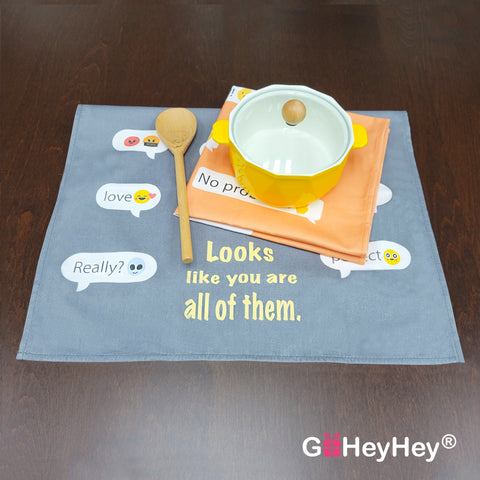A Happy Beginning of an Eco-friendly Kitchen with Tea Towels
Mar 15,2022 | K Yam
A nice piece of kitchen ware, from a pot to a piece of towel, can be cheering, inspirational and reflects one’s personal taste of home and living. Moreover, while nowadays everyone is keen on preserving our planet by reducing waste, kitchen is certainly a place where many waste come from, say paper towels, plastic utensils, plastic wraps, etc. Therefore, tea towel is a happy and pragmatic beginning of an eco-friendly kitchen.
What is a tea towel, anyway? Well, it started as an accessory for the rich in Britain in 18th century during Queen Victoria’s reign. Ladies of wealthy families used tea towels to clean their delicate bone china, wrap their food and expensive tea pot. It was a quality and presentable piece for teatime. Then in 19th century, this culture spread to countries which were part of the British Empire. Many tea towels at that time were decorated with hand stitching and embroideries that showcased women’s sewing skills.
Then, in early 20th century, the concept of tea towel evolved in United States as people did not use light weight cotton or linen but rather use reused materials such as rough cotton of animal feed sacks. The users were also changed from rich ladies in Britain to ordinary housewives in US. That’s why tea towels were also called “flour sack towels”.
Is tea towel dish cloth?
Today, all towels used in the kitchen are generalized as “kitchen towels” or “dish cloth”. However, towels that is made of terry cloth can be called “dish cloth”, while tea towels can only be made by 100% woven cotton/linen. Moreover, the distinctiveness of tea towel is that it is more than just a functional piece but also demonstrate one’s discerning taste of dining presentation. That’s why most tea towels are decorated with print patterns or embroideries.
Tea towel is not only a dish cloth, but a presentable piece in a household. When having guests coming over for dinner, it is preferable to use a tea towel than an ordinary terry cloth in front of your guests.
What material is tea towel made of?
Tea towels should be good absorbent, soft, light weight and lint-free. Thus, light weight cotton woven, linen or combination of both are the most suitable materials as they don't leave any lint or marks on objects. This unique feature makes it very suitable to wipe or dry delicate utensils such as chinaware, wine bottle and wine glasses.
Nowadays, some tea towels that we see in shops are made of cotton twill, which is slightly stiffer and less soft than cotton/linen woven. In my opinion, cotton twill is not a good choice for tea towels in terms of absorbency due to its weaving method and as well softness. Moreover, a large area of printing with silkscreen method tremendously reduces the ability of absorbency.
Today, we do not just use tea towels during teatime like the British ladies in 18th century. The usages of tea towel are now more versatile. Hence, in my opinion, tea towels should still be soft but should also be slightly higher density (or slightly thicker) cotton or linen fabric than before.
Be eco-friendly, use tea towels!
Tea towel is an excellent piece to replace paper towel, tissue or gift wrapping in many ways. It is reusable, washable, durable and beautiful. Today, tea towel evolves more than just a towel for wiping spills from dishes or cleaning exquisite dining wares. Using tea towels is an eco-friendly way to reduce waste!
Here’re some common ways to use tea towels:
- Hand towels (A nice hanging piece in the kitchen or bathroom)
- Wipe off spills on tables, dishes and counters
- Clean delicate chinaware, glassware and tableware, especially wine glasses
- Use as strainer (excellent for squeezing out excessive water from frozen vegetables)
- Dry fruit and veggies
- Wrap bread
- Liner for baked goods
- Reusable gift wrap
- Napkin
- Potholder
- Placemat
Product safety
Because we use tea towels to handle food and utensils, we should pay extra attention to product safety, which in fact, are often neglected by many designers and users.
We often see many tea towels, which are printed with beautiful patterns all over. Most of them are stiff hand feel. This is because they are screen printed with a layer of color ink on the fabric surface. The advantage of this is that the manufacturing cost is low, and the colors really stand out and solid, but it significantly reduces the absorbency of cotton fabrics. Also, the hand feel is noticeably stiff.
Another issue of such printing method pertains to color fastness, especially on dark colors. This means that colours could transfer to other garments or food if the printing ink is not in reasonable quality, or fixation isn’t treated appropriately.
Therefore, we recommend users to prewash the tea towels prior to using. Also, try to choose tea towels that is soft hand feel because
(1) that implies little chemical coating additives
(2) that implies patterns are mostly likely printed by better printing process, in which ink are diffused into the fabric rather than staying on the surface. Usually, this type of tea towels has lower chance of color migration or color fastness.
Tea towels is a practical, multi-usage, low price, reusable and biodegradable piece for your kitchen and home. Next time, when you want to use kitchen paper towel to do the work, try using tea towels instead.
Check out our creative modern designs of tea towels that make you smile!













